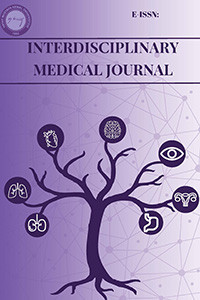TİMOLOL/BRİNZOLOMİD KOMBİNASYONU İLE TİMOLOL/DORZOLOMİD KOMBİNASYONUN GÖZ TANSİYONU AÇISINDAN KARŞILAŞTIRILMASI
Timolol/Brinzolomid, Timolol/Dorzolomid, Göz Tansiyonu
Comparison the effect of timolol/brinzolomid and timolol/ dorzolamid fixedcombination drugs on intraocular pressure
timolol/brinzolomid, timolol/ dorzolamid, intraocular pressure,
___
- Sanseau A, Sampaolesi J, Suzuki ER Jr, Lopes JF, Borel H. Preference for a fixed combination of
- brinzolamide/timolol versus dorzolamide/timolol among patients with open-angle glaucoma or ocular
- hypertension. Clin Ophthalmol. 2013;7:357-62.
- Kass MA, Heuer DK, Higginbotham EJ. The Ocular Hypertension Treatment Study: a randomized
- trial determines that topical ocular hypotensive medication delays or prevents the onset of primary
- open-angle glaucoma. Arch Ophthalmol. 2002;120:701–713.
- European Glaucoma Society. Terminology and Guidelines for Glaucoma. 3rd ed. 87-88.
- Boyle JE, Ghosh K, Gieser DK, Adamsons IA. Ophthalmology A randomized trial comparing the
- dorzolamide-timolol combination given twice daily to monotherapy with timolol and dorzolamide.
- Ophthalmology. 1999;106:10-6.
- Strohmaier K, Snyder E, DuBiner H, Adamsons I. The efficacy and safety of the dorzolamidetimolol
- combination versus the concomitant administration of its components. Dorzolamide-Timolol
- Study Group.Ophthalmology. 1998;105(10):1936-44.
- Kaback M, Scoper SV, Arzeno G, et al. Brinzolamide 1%/Timolol 0.5% Study Group. Intraocular
- pressure-lowering efficacy of brinzolamide 1%/timolol 0.5% fixed combination compared with
- brinzolamide 1% and timolol 0.5%. Ophthalmology. 2008;115:1728–1734, 1734.
- Vold SD, Evans RM, Stewart RH, Walters T, Mallick S. A one-week comfort study of BID-dosed
- brinzolamide 1%/timolol 0.5% ophthalmic suspension fixed combination compared to BID-dosed
- dorzolamide 2%/timolol 0.5% ophthalmic solution in patients with open-angle glaucoma or ocular
- hypertension. J Ocul Pharmacol Ther. 2008 ;24:601-5.
- Manni G, Denis P, Chew P, Sharpe ED, Orengo-Nania S, Coote MA, Laganovska G, Volksone L,
- Zeyen T, Filatori I, James J, Aung T. The safety and efficacy of brinzolamide 1%/timolol 0.5% fixed
- combination versus dorzolamide 2%/timolol 0.5% in patients with open-angle glaucoma or ocular
- hypertension. J Glaucoma. 2009 ;18:293-300.
- Barnebey H1, Kwok SY. Patients' acceptance of a switch from dorzolamide to brinzolamide for the
- treatment of glaucoma in a clinical practice setting. Clin Ther. 2000 ;22:1204-12.
- Mulaney J, Sonty S, Ahmad A, Stewart JA, Stewart WC. Comparison of daytime efficacy and
- safety of dorzolamide/timolol maleate fixed combination versus latanoprost. Eur J Ophthalmol.
- ;18:556–62.
- Parmaksiz S, Yuksel N, Karabas VL, Ozkan B, Demirci G, Caglar Y. A comparison of travoprost,
- latanoprost, and the fixed combination of dorzolamide and timolol in patients with pseudoexfolitation
- glaucoma. Eur J Ophthalmol. 2006;16:73–80
- Yayın Aralığı: Yılda 3 Sayı
- Başlangıç: 2023
- Yayıncı: Hatay Mustafa Kemal Üniversitesi Tıp Fakültesi Dekanlığı
Mustafa Özçil, Arif Güngören, Ali Hakverdi, Hasan Gökçe, Orhan Nural
LOMBER DİSK HASTALARINDA AŞIRI AKTİF MESANE SENDROMUNUN DEĞERLENDİRİLMESİ
KLİNİĞİMİZE BAŞVURAN MOL GEBELİK OLGULARININ RETROSPEKTİF İNCELENMESİ: 5 YILLIK KLİNİK DENEYİM
Atilla Karateke, Raziye Kurt, Mehmet Dede, Ayhan Gül, Çetin Kılıç, Defne Özkaya
NEURONAVIGATION: A REVOLUTIONARY STEP OF NEUROSURGERY AND ITS EDUCATION
ISOLATED TRANSVERSE SACRUM FRACTURE AND ITS IMPLICATIONS: A CASE REPORT
EŞ ZAMANLI 2 AYRI ODAKTA KÜÇÜK HÜCRELİ AKCİĞER KARSİNOMUYLA BAŞVURAN SINIRLI EVREDEKİ BİR OLGU
NADİR GÖRÜLEN BİR BENİGN YUMUŞAK DOKU TÜMÖRÜ; ELASTOFİBROMA DORSİ
Ömer Yıldız, Raif Özden, İbrahim Duman, Vedat Uruç, Yunus Doğramacı, Aydıner Kalacı
Gökhan Arslan, Ali Karakuş, Koca Çalışkan, Mustafa Şahan, Mehmet Duru, Güven Kuvandık, Yakup Erdoğan
